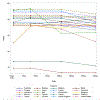Perceived Interruptions to HIV Prevention and Treatment Services Associated With COVID-19 for Gay, Bisexual, and Other Men Who Have Sex With Men in 20 Countries
- PMID: 33443963
- PMCID: PMC8276834
- DOI: 10.1097/QAI.0000000000002620
Perceived Interruptions to HIV Prevention and Treatment Services Associated With COVID-19 for Gay, Bisexual, and Other Men Who Have Sex With Men in 20 Countries
Abstract
Background: The coronavirus pandemic has necessitated a range of population-based measures to stem the spread of infection. These measures may be associated with disruptions to other health services including for gay, bisexual, and other men who have sex with men (MSM) at risk for or living with HIV. Here, we assess the relationship between stringency of COVID-19 control measures and interruptions to HIV prevention and treatment services for MSM.
Setting: Data for this study were collected between April 16, 2020, and May 24, 2020, as part of a COVID-19 Disparities Survey implemented by the gay social networking app, Hornet. Pandemic control measures were quantified using the Oxford Government Response Tracker Stringency Index: each country received a score (0-100) based on the number and strictness of 9 indicators related to restrictions, closures, and travel bans.
Methods: We used a multilevel mixed-effects generalized linear model with Poisson distribution to assess the association between stringency of pandemic control measures and access to HIV services.
Results: A total of 10,654 MSM across 20 countries were included. Thirty-eight percent (3992/10,396) reported perceived interruptions to in-person testing, 55% (5178/9335) interruptions to HIV self-testing, 56% (5171/9173) interruptions to pre-exposure prophylaxis, and 10% (990/9542) interruptions to condom access. For every 10-point increase in stringency, there was a 3% reduction in the prevalence of perceived access to in-person testing (aPR: 0·97, 95% CI: [0·96 to 0·98]), a 6% reduction in access to self-testing (aPR: 0·94, 95% CI: [0·93 to 0·95]), and a 5% reduction in access to pre-exposure prophylaxis (aPR: 0·95, 95% CI: [0·95 to 0·97]). Among those living with HIV, 20% (218/1105) were unable to access their provider; 65% (820/1254) reported being unable to refill their treatment prescription remotely.
Conclusions: More stringent responses were associated with decreased perceived access to services. These results support the need for increasing emphasis on innovative strategies in HIV-related diagnostic, prevention, and treatment services to minimize service interruptions during this and potential future waves of COVID-19 for gay men and other MSM at risk for HIV acquisition and transmission.
Copyright © 2021 Wolters Kluwer Health, Inc. All rights reserved.
Conflict of interest statement
The authors have no conflicts of interest to disclose.
Figures


References
-
- Health Intervention Tracking for COVID-19 (HIT-COVID): a living global database. https://akuko.io/post/covid-intervention-tracking.
-
- Hale T, Webster S, Petherick A, Phillips T, Kira B. Oxford COVID-19 Government Response Tracker. Blavatnik School of Government. 2020; http://www.bsg.ox.ac.uk/covidtracker. - PubMed
-
- UNAIDS. Trend of new HIV infections. 2020; https://aidsinfo.unaids.org/.
-
- UNAIDS. 2020 Global AIDS Update — Seizing the moment — Tackling entrenched inequalities to end epidemics. 2020; https://www.unaids.org/en/resources/documents/2020/global-aids-report.
Publication types
MeSH terms
Grants and funding
LinkOut - more resources
Full Text Sources
Other Literature Sources
Medical
Miscellaneous

